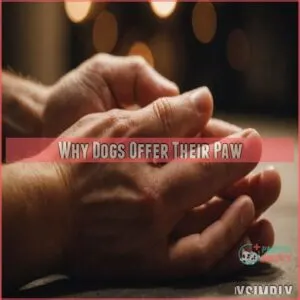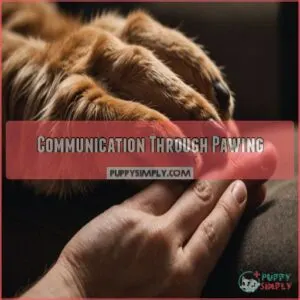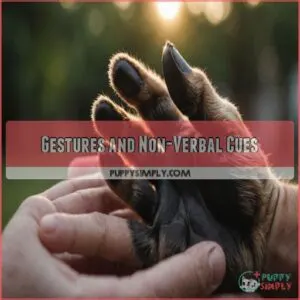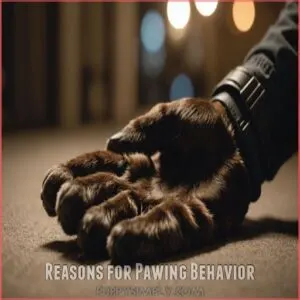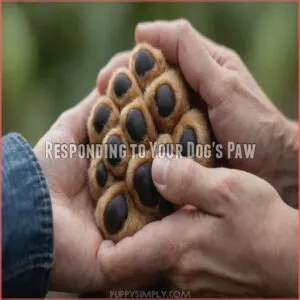This site is supported by our readers. We may earn a commission, at no cost to you, if you purchase through links.
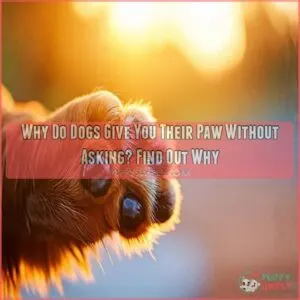 When your dog gives you their paw without asking, it’s their way of saying, "Hey, pay attention to me!"
When your dog gives you their paw without asking, it’s their way of saying, "Hey, pay attention to me!"
Dogs use this gesture to seek attention, show affection, or sometimes even apologize—imagine your pup saying, "Oops, my bad!"
It might also be a learned behavior from training, or simply a charming display of trust and connection.
Dogs have a paw-sitively unique way of communicating, whether they’re expressing excitement or subtly asking for a treat.
Keep an eye out for their body language, which often tells you exactly what they need.
Want to understand your furry friend even better? Read on!
Table Of Contents
- Key Takeaways
- Why Dogs Offer Their Paw
- Communication Through Pawing
- Emotional Bonding and Trust
- Canine Communication Styles
- Reasons for Pawing Behavior
- Responding to Your Dog’s Paw
- Frequently Asked Questions (FAQs)
- Why do dogs put their paws on You?
- Why do dogs give you paws without asking?
- Should a dog put a paw on You?
- Why is my dog pawing me?
- Why does my dog put his paw on my hand?
- Why does my dog want to touch me with her paw?
- What is the importance of physical contact in bonding and trust?
- How do dogs communicate with humans?
- What is the significance of dogs offering their paw?
- What are the different interpretations of pawing?
- How can pawing help build a stronger bond with dogs?
- How should owners respond to pawing behavior?
- Why do dogs offer their paw as an expression of love?
- How can pawing help understand dog needs?
- Why does my dog randomly give me paws?
- Why does my dog give me his paw when I don’t ask for it?
- Why does my dog keep tapping me with his paw?
- Is a dog putting a paw on me dominance?
- How does pawing vary between dog breeds?
- Can pawing indicate a dogs health issue?
- Do age or maturity affect pawing behavior?
- What should I do if pawing increases?
- How can I train my dog to stop pawing?
- Conclusion
Key Takeaways
- Dogs give you their paw as a way to seek attention or express affection, signaling a desire to connect with you.
- This behavior can be a learned response from training or positive reinforcement, where your reaction encourages them to repeat it.
- Pawing is a form of communication that can indicate they want something specific, like food or a bathroom break, or that they need comfort.
- Understanding your dog’s body language and pawing helps strengthen your bond, improving your relationship through better communication.
Why Dogs Offer Their Paw
When your dog offers you their paw without asking, it’s often their way of seeking attention or affection, and sometimes it’s because they’ve learned it works wonders for getting a treat or a pet.
This simple gesture can indicate trust and a desire to connect, much like how you might extend a handshake to a friend—or perhaps they just think you’re not pampering them enough!
Seeking Attention and Affection
Ever noticed how dogs often give their paw to seek attention and affection?
It’s their way of saying, “Hey, notice me!” and it’s adorable.
Here’s why they do it:
- Pawing for petting: Dogs love language includes touch.
- Affectionate gestures: They’re initiating bonding rituals.
- Positive reinforcement: Responding to their pawing encourages this cute behavior.
Displaying Trust and Connection
You’ve noticed your dog offering its paw, a gesture full of meaning.
Beyond seeking affection, paw-giving symbolizes trust and connection.
It’s like a handshake in the dog world, building a bond with you.
Here’s how this canine behavior plays out:
| Behavior | Meaning |
|---|---|
| Pawing as Greeting | Seeking connection |
| Canine Social Cues | Building a bond |
| Body Language | Expressing safety |
| Trust and Safety | Promoting trust |
Responding to Learned Behavior
Just like building trust, dogs offer their paw as they respond to learned behavior. It’s cute when they mimic training cues or routines. Keep rewards ready, and remember: consistency matters.
With cue recognition, dogs smartly figure out:
- Pawing gets treats or pets.
- It’s part of dog training fun.
- Reinforcement strategies work wonders.
- It’s clever attention-seeking!
Communication Through Pawing
When your dog offers a paw, it’s not just a random act—it’s their way of communicating, whether they’re feeling excited, seeking affection, or needing something specific.
This pawing can signal anything from a simple "hello" to a more pressing request for attention or comfort, much like a friend tapping your shoulder to get your attention.
Expressing Excitement or Affection
So, your dog offers a paw—cute, right?
It’s more than just a gesture; it’s a way they show affection and excitement.
Think of it as a furry handshake, combined with a happy bark and tail wags.
When your dog does this, it might be worth reading up on why dogs paw.
That pawing, along with intense eye contact and maybe even a lick, says, "I’m so happy to see you!"
It’s their way of bonding with you, offering emotional support through a simple, sweet action.
They’re basically saying, "I love you!" in their own special way.
Initiating Physical Contact
Think of your dog’s paw as a furry high-five.
Dogs use pawing rituals to initiate physical contact, reinforcing that bond of trust and canine intimacy.
It’s like their way of saying, “Hey, I’m here for a snuggle!”
This affectionate gesture speaks volumes in dog touch language, showcasing their innate desire for physical bonding and emotional connection with you.
Conveying Needs or Discomfort
Ever notice a dog pawing at you?
It’s often more than a cute plea.
This subtle form of communication can reveal their needs or discomfort.
Here are three things to watch for:
- Paws for Relief: They might seek help if feeling anxious.
- Recognizing Distress: Tail, ears, and paws speak volumes.
- Nonverbal Cues: Quiet signs say a lot.
Emotional Bonding and Trust
When your dog gives you their paw, it’s more than just a cute gesture—it’s a sign of emotional bonding and trust.
This simple act releases oxytocin, often called the "love hormone," strengthening the special connection you share.
Releasing Oxytocin Through Physical Contact
When your dog offers a paw, it’s not just a polite gesture.
This simple act can trigger the power of oxytocin, the "bonding hormone," strengthening the dog-human connection.
You can even find oxytocin-related products for your dog’s paw care on this dog paw oxytocin website.
Through touch therapy, petting your dog releases oxytocin, enhancing trust and emotional bonding.
Imagine it like your dog’s way of saying, "I trust you," without talking.
Physical contact offers immense benefits, like lowering stress for both you and your pup.
It’s a natural way to solidify your bond, making every pet and cuddle a stepping stone to deeper trust and friendship.
Strengthening The Emotional Connection
Imagine your dog offering a paw like an olive branch—sweet, right?
This gesture, tied to Dog-Human Communication, showcases their desire to connect.
By understanding needs through body language, you’re not just building trust; you’re crafting a bond rooted in comfort and reassurance.
Using positive reinforcement techniques, like clicker training and treat motivation, can further strengthen this connection.
When your pup paws at you, they’re extending a strategy for emotional connection.
Positive Reinforcement strengthens their trust, just like a comforting pat can do wonders for their little souls.
Embrace these moments; they’re more than gestures—they’re a reflection of your loving companionship.
Canine Communication Styles
When your dog gives you their paw without being asked, they’re communicating in a way that combines body language and non-verbal cues.
By understanding these gestures, you can decipher the secrets of your dog’s mood and intentions, ensuring a stronger bond and better communication.
Vocalizations and Body Language
Many dogs use a combination of vocalizations and body language to communicate.
You’ll notice tail wags, ear positions, and facial expressions offering clues to their feelings.
A happy bark sounds different from a scared whine.
Observing these dog signals helps you understand canine communication better.
It’s like learning a new language, but far more rewarding!
Paying attention to their body language improves your bond.
Gestures and Non-Verbal Cues
Spot your dog’s gestures and non-verbal cues, like tail wags and ear positions, for clear communication.
A paw might mean, "Hey, let’s chat," or "I need something."
Their body language, full of calm gestures and nonthreatening postures, helps them say, "I trust you."
It’s like learning a new language—listen closely, and you’ll understand your furry friend’s nuanced chatter.
Understanding Emotional Intelligence in Dogs
When understanding dog behavior, non-verbal cues, such as gentle nibbling, also known as dog love bites, offer a wealth of insights.
Recognizing dog emotions is like reading their personal diary without the lock.
Canine communication involves emotional intelligence where your pet’s instincts and body language reveal feelings.
Training cues become a conversation, deepening animal bonding.
You’re engaging in a dialogue, full of unspoken but deeply felt connections.
Reasons for Pawing Behavior
When your dog gives you their paw without asking, it might be their way of saying "I’m hungry" or "let’s go outside."
They could also be asking you to keep on petting them or letting you know they’re seeking comfort, much like they’re giving you a little high-five.
They’re Hungry or Need to Go Outside
Pawing isn’t just random; it’s your pup’s way of telling you something.
Maybe they’re hungry, craving kibble, or hinting it’s time for a bathroom break.
Establishing a daily care routine for dogs, like the ones found in a pet parents guide, helps you recognize these pawing cues.
Recognizing these pawing cues helps with potty training and prevents accidents.
As a dog owner, understanding their needs strengthens your bond.
Keep things consistent—clear communication methods reinforce behavior and improve pet care.
They Want You to Continue or Stop an Activity
Your furry friend’s paw can be a request to either keep doing what you’re doing or knock it off.
They’re masters at reading our cues, just like you read theirs:
- Want more attention? They’re all paws on deck.
- Had enough? A gentle stop sign.
- Sensing discomfort? Respect those doggy limits and adjust your petting game.
They’re Petting You Back or Seeking Comfort
Ever notice how your dog’s paw lands on you like a gentle nudge?
It’s their way of "petting" you back, signaling a unique form of connection.
This furry gesture can also mean they’re seeking comfort.
Dogs, much like us, crave that sense of companionship and emotional wellbeing.
Embrace these moments; they strengthen your bond and enhance your relationship.
Responding to Your Dog’s Paw
So, your dog just offered you their paw; understanding their gesture is key to building a stronger bond.
Responding appropriately, whether it’s a playful nudge or a plea for comfort, strengthens your relationship and helps you understand your furry friend better.
Positive Reinforcement and Consistency
Sometimes dogs offer their paw for attention or food, and it’s important to recognize when they’re seeking relief from issues like a dog paw raw.
It’s all about rewards and timing.
When your furry friend raises a paw, positive reinforcement is key.
Offer a treat or praise when they obey commands, reinforcing good behavior.
Consistency in training helps prevent mistakes.
Understanding dog psychology fosters a stronger dog-human interaction, creating a peaceful domesticated dog environment.
Addressing Underlying Needs and Emotions
Understanding your dog’s needs involves recognizing their emotional signals.
When they paw you, they’re often seeking comfort or expressing anxiety.
Just like humans, dogs crave reassurance.
Respond with gentle petting or a soothing voice.
It’s about being in tune with your pet’s emotions and offering the emotional support they need, making them feel safe and loved.
Building a Stronger Bond Through Communication
Offering a paw can be your dog’s way of striking up a chat.
This simple gesture strengthens your bond by honing your skills in dog language.
You can also encourage this behavior by incorporating fun activities found in paw trick training guides.
Respond with playful communication and positive reinforcement, turning paw-giving into a trust exercise.
Embrace these moments—they’re a peek into your pup’s instinctual behavior, making you both happier social animals and better animal lovers.
Frequently Asked Questions (FAQs)
Why do dogs put their paws on You?
Did you know 80% of dog owners experience unprompted pawing?
Your pup might use their paw to seek attention, convey affection, or signal needs.
It’s like their way of dialing into your friendship line!
Why do dogs give you paws without asking?
It’s a sweet gesture!
Dogs offer paws for various reasons: attention, affection, or to signal a need.
It’s their way of communicating; sometimes it’s learned, sometimes instinct.
They’re simply sharing a connection.
Should a dog put a paw on You?
Imagine a furry friend placing a paw on your leg; it’s like a gentle hello.
Dogs do this to show affection, seek attention, or communicate.
It can be a sweet expression of their bond with you.
Why is my dog pawing me?
Your dog might paw you for attention, signaling a need like petting or play.
Maybe they’re hungry, anxious, or keen to continue an activity.
Dogs use pawing as communication, so watch their cues for clues.
Why does my dog put his paw on my hand?
You might worry your dog is manipulating you, but pawing can actually be a heartfelt gesture.
It often means your dog seeks affection, wants to bond, or is simply expressing love, needing your attention or comfort.
Why does my dog want to touch me with her paw?
Dogs often touch you with their paws to seek attention, express affection, or communicate a need.
It’s like their way of saying, "Hey, I’m here!"
Understanding pawing can strengthen your bond, making those lil’ gestures meaningful.
What is the importance of physical contact in bonding and trust?
Physical contact is essential for bonding and trust as it releases oxytocin, the "bonding hormone."
This strengthens connections but also provides comfort and security, making you feel more loved and secure in relationships.
How do dogs communicate with humans?
Imagine your dog as a furry conversationalist using barks, tail wags, and adorable eye contact to chat with you.
They rely on vocalizations and body language to express emotions, needs, and even sneak in playful requests.
What is the significance of dogs offering their paw?
It’s a sweet gesture! Your dog might want attention, affection, or to simply connect. It’s their way of saying, "Hey there, friend!" Sometimes, it’s just a learned trick, too.
What are the different interpretations of pawing?
Dogs paw for various reasons: seeking attention or affection, signaling discomfort, or expressing anxiety.
It can indicate a desire to continue an activity.
Observing your dog’s context and body language helps interpret pawing accurately.
How can pawing help build a stronger bond with dogs?
Who would’ve thought a simple paw could strengthen your bond?
When your dog offers their paw, it’s like a handshake, boosting trust and affection.
Respond positively to show you enjoy their company, deepening your connection.
How should owners respond to pawing behavior?
Greet pawing with patience and positivity.
Recognize it’s a request for attention or comfort.
Respond consistently; offer a gentle pat or verbal reassurance.
Understanding your dog’s needs fosters a stronger bond and happier relationship.
Why do dogs offer their paw as an expression of love?
Imagine your dog offering you their paw as a high-five of affection.
This simple gesture can be their way of saying "I love you," showcasing trust, bonding, and the desire to strengthen your connection.
How can pawing help understand dog needs?
Pawing offers insights into your dog’s feelings and needs, like asking for attention, affection, or even signaling discomfort.
This gesture is their cute way of saying, "Hey, notice me!"
Pay attention to cues and context.
Why does my dog randomly give me paws?
Actions speak louder than words, especially with dogs.
Your dog might randomly give you its paw to seek attention, show affection, or signal a specific need.
It’s often their way of saying "let’s connect" or "notice me.
Why does my dog give me his paw when I don’t ask for it?
Your dog might offer a paw for attention, affection, or to signal a need. It’s a learned behavior, sometimes mimicking you! They’re clever communicators, aren’t they?
Why does my dog keep tapping me with his paw?
If your dog keeps tapping you with his paw, it’s likely a sign of affection, a desire for attention, or a need for comfort.
Try responding with gentle interaction to see what he needs.
Is a dog putting a paw on me dominance?
Picture a gentle touch as your dog places a paw on you.
It’s not about dominance but often about seeking affection or attention.
This simple gesture reflects trust and a desire for connection, not control.
How does pawing vary between dog breeds?
Pawing varies by breed due to differences in temperament and communication styles.
For instance, Labradors may paw gently for attention, while Terriers show persistent pawing, reflecting their energetic nature.
Each breed’s behavior reflects their unique personalities and instincts.
Can pawing indicate a dogs health issue?
Like a red flag in smooth waters, a dog’s insistent pawing can signal a health issue.
It may seek comfort if feeling unwell or in pain.
Observe other symptoms like limping or changes in behavior.
Do age or maturity affect pawing behavior?
As dogs age, their pawing behavior can change.
Younger dogs might paw more frequently from curiosity or playfulness.
Whereas older dogs may do so for affection or attention, reflecting changes in their needs and energy levels.
What should I do if pawing increases?
A stitch in time saves nine! If your dog’s pawing increases, gently redirect their attention. Ignoring unwanted behavior often works best. Consider if underlying anxiety needs addressing.
How can I train my dog to stop pawing?
Teach your dog to stop pawing by consistently ignoring the behavior and rewarding them when they’re calm.
Redirect attention with toys or commands.
Make sure they get plenty of exercise and mental stimulation to keep them happily engaged.
Conclusion
Like a gentle nudge from a friend, when your dog gives you their paw without asking, it’s their unique way of communicating.
Understanding this behavior—whether they’re seeking attention, showing affection, or simply copying a learned trick—helps strengthen your bond.
Pay attention to their pawing, as it might signal needs like hunger or comfort, and use this to connect more deeply.
Your dog’s actions speak volumes about their emotions and trust in you.

